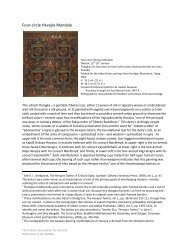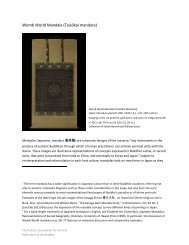Reflections of the Buddha - The Pulitzer Foundation for the Arts
Reflections of the Buddha - The Pulitzer Foundation for the Arts
Reflections of the Buddha - The Pulitzer Foundation for the Arts
Create successful ePaper yourself
Turn your PDF publications into a flip-book with our unique Google optimized e-Paper software.
tradition that referenced <strong>the</strong> sacred text (sūtra) known as<br />
<strong>the</strong> “Discourse on Characteristics,” or <strong>the</strong> Lakkhana Sutta<br />
in Pāli. This text enumerates <strong>the</strong> thirty-two characteristics<br />
<strong>of</strong> great men like <strong>the</strong> <strong>Buddha</strong>, including legs like an<br />
antelope’s, a penis that is covered by a sheath, a frame<br />
that is divinely straight, and shoulders with no furrow<br />
between <strong>the</strong>m. <strong>The</strong> sculptors heightened <strong>the</strong>se<br />
attributes by carving a transparent drapery comprised <strong>of</strong><br />
ringed folds in relief that systematically cascade down<br />
and across <strong>the</strong> body.<br />
Most artists created works anonymously yet<br />
each showed great originality and craftsmanship. <strong>The</strong>y<br />
culled ideas from outsiders — itinerant artists as well as<br />
travelling Buddhist clerics and lay practitioners who<br />
brought <strong>the</strong>ir own statues, sūtras, and o<strong>the</strong>r religious objects<br />
with <strong>the</strong>m. <strong>The</strong>se items influenced <strong>the</strong> practices,<br />
iconography, and styles <strong>of</strong> <strong>the</strong> local workshop. As depictions<br />
<strong>of</strong> <strong>Buddha</strong>s and bodhisattvas moved from Pakistan,<br />
Afghanistan, and India to o<strong>the</strong>r parts <strong>of</strong> Asia, styles were<br />
adapted to suit <strong>the</strong> tastes <strong>of</strong> <strong>the</strong> local cultures. For instance,<br />
<strong>the</strong> artist <strong>of</strong> <strong>the</strong> Chinese Standing <strong>Buddha</strong><br />
Śākyamuni (no. 9) did not directly incorporate <strong>the</strong> Indian<br />
Gupta style sometime around 600, but what is apparent<br />
is his more mediated acceptance <strong>of</strong> it. This is seen in <strong>the</strong><br />
rounded shoulders, <strong>the</strong> hint <strong>of</strong> <strong>the</strong> leg underneath <strong>the</strong><br />
robe’s cascading pleats, and <strong>the</strong> nudity <strong>of</strong> his chest.<br />
An intermingling <strong>of</strong> styles may also be seen<br />
between Bodhisattva Avalokiteśvara in <strong>the</strong> Form <strong>of</strong> Khasarpana<br />
Lokeśvara (no. 17), from ei<strong>the</strong>r Bihar or Bengal during<br />
<strong>the</strong> Pāla period (750 – 1150) in India, and Bodhisattva<br />
Avalokiteśvara (no. 14), from Nepal during <strong>the</strong> Transitional<br />
period (c. 879 – 1200). Both works depict bodhisattvas as<br />
Brahman princes with smooth and rounded bodies,<br />
which are decorated elaborately with necklaces, armbands,<br />
diadems, earrings, and sacred threads that wrap<br />
around <strong>the</strong> figures’ left shoulders, <strong>the</strong>n down and around<br />
<strong>the</strong>ir right thighs. Both have stacked braided hair and<br />
sheer dhotis that cling to <strong>the</strong>ir bodies. <strong>The</strong> thin-waist torsos<br />
have similar belly clefts that protrude just over <strong>the</strong>ir<br />
belts, <strong>the</strong>ir hips move to one side, and <strong>the</strong>ir fleshy palms<br />
and animated fingers hold (or once held, in <strong>the</strong> case <strong>of</strong><br />
<strong>the</strong> Nepalese work) lotus stems. <strong>The</strong> resemblances between<br />
<strong>the</strong> works attest to <strong>the</strong> flow <strong>of</strong> artists, mystics,<br />
monks, and lay practitioners who travelled back and<br />
<strong>for</strong>th between eastern India and <strong>the</strong> Nepal’s Kathmandu<br />
Valley <strong>for</strong> centuries. 5<br />
O<strong>the</strong>r instances <strong>of</strong> cultural exchange in <strong>the</strong><br />
exhibition may be seen between <strong>the</strong> Nepalese Bodhisattva<br />
Avalokiteśvara (no. 14) and <strong>the</strong> Mongolian Standing<br />
Bodhisattva Maitreya (no. 16). During <strong>the</strong> seventeenth century,<br />
<strong>the</strong> renowned Mongolian monk Zanabazar (1635<br />
– 1723), <strong>the</strong> son <strong>of</strong> a prominent family <strong>of</strong> <strong>the</strong> Khalkha<br />
Mongols, learned to make works <strong>of</strong> art inspired by<br />
Nepalese sculptures while training to be a Buddhist<br />
monk in Tibet. He returned to Mongolia with a convoy <strong>of</strong><br />
clerics and artisans and built monasteries and workshops<br />
where sculptures like Standing Bodhisattva Maitreya were<br />
cast <strong>for</strong> monastic altars. In this way, early Nepalese<br />
9<br />
traditions <strong>of</strong> making and rendering Buddhist figures<br />
made <strong>the</strong>ir way into Mongolia. 6<br />
Incised inscriptions and symbols on Buddhist<br />
sculptures provide hints to understanding why and when<br />
sculptures were made. Yet trying to fully grasp <strong>the</strong> institutional<br />
and ritual contexts <strong>of</strong> a Buddhist image that is<br />
now part <strong>of</strong> a museum collection may be problematic given<br />
<strong>the</strong> difficulty <strong>of</strong> determining a function on <strong>the</strong> basis <strong>of</strong><br />
appearance alone, and given <strong>the</strong> high probability that a<br />
single object had multiple purposes. Indeed, inscriptions<br />
carved on <strong>the</strong> bases <strong>of</strong> Buddhist sculptures convey that<br />
patrons sought a wide range <strong>of</strong> benefits through such<br />
commissions, both worldly and o<strong>the</strong>rworldly. Among<br />
worldly benefits were good health and wealth, success in<br />
a military campaign, longevity, and <strong>the</strong> happiness and<br />
welfare <strong>of</strong> all people. O<strong>the</strong>rworldly benefits included <strong>the</strong><br />
acquisition <strong>of</strong> karmic merit <strong>for</strong> <strong>the</strong> donors and <strong>the</strong>ir families,<br />
guilds, or o<strong>the</strong>r community groups. Karma is <strong>the</strong><br />
universal law <strong>of</strong> cause and effect: Actions in this life will<br />
determine <strong>the</strong> <strong>for</strong>m in which an individual will be reborn<br />
in <strong>the</strong> next life. Such commissions thus would advance<br />
patrons on <strong>the</strong> path toward Nirvāna.<br />
A desire to accrue karmic merit was likely one<br />
<strong>of</strong> <strong>the</strong> factors behind <strong>the</strong> making <strong>of</strong> Seated Bodhisattva<br />
Tārā in her “Green Manifestation” (no. 15). Tārā, one <strong>of</strong> <strong>the</strong><br />
most beloved deities <strong>of</strong> Vajrayāna Buddhists, has <strong>the</strong> ability<br />
to save beings from <strong>the</strong> eight dangers (pride, delusions,<br />
hatred, envy, fanatical views, avarice, lust, and doubts). 7<br />
Of Tārā’s twenty-one <strong>for</strong>ms, her green manifestation<br />
is considered her most active. Inscribed on <strong>the</strong> base <strong>of</strong><br />
this sculpture, near Tārā’s right foot, is <strong>the</strong> following inscription:<br />
大明永樂年施 (Da Ming Yonglenian shi), which<br />
may be translated: “Donated [during <strong>the</strong>] Yongle reign [<strong>of</strong><br />
<strong>the</strong>] Great Ming [dynasty].” 8 This indicates that <strong>the</strong> sculpture<br />
was likely produced in an imperial workshop <strong>of</strong> <strong>the</strong><br />
Chinese Yongle Emperor, a Vajrayāna practitioner who<br />
reigned from 1402 to 1424. <strong>The</strong> term shi 施 (“donated”)<br />
suggests that it was produced specifically as a gift, possibly<br />
<strong>for</strong> a Buddhist temple as far away as Tibet. 9<br />
On <strong>the</strong> underside <strong>of</strong> <strong>the</strong> sculpture Seated<br />
Bodhisattva Tārā is a removable plate incised with an image<br />
<strong>of</strong> crossed vajras — ritual implements with curved<br />
prongs at each end symbolizing <strong>the</strong> thunderbolt/diamond<br />
path <strong>of</strong> Vajrayāna Buddhists (fig. 1, page 10). <strong>The</strong> vajra denotes<br />
<strong>the</strong> indestructible, immutable, and brilliant nature<br />
<strong>of</strong> Buddhist reality. Normally, <strong>the</strong> crossed-vajra symbol<br />
protects <strong>the</strong> sacred objects inside. <strong>The</strong> practice <strong>of</strong> inserting<br />
objects is <strong>of</strong>ten associated with <strong>the</strong> consecration <strong>of</strong> a<br />
Buddhist object as an icon: Inserted objects were thought<br />
in some cases to enhance <strong>the</strong> power <strong>of</strong> “<strong>the</strong> unseen<br />
Sacred and to increase its degree <strong>of</strong> presence in <strong>the</strong><br />
image.” 10 Some included objects have also been associated<br />
with talismans, which possess <strong>the</strong> magic to protect, heal,<br />
and bring good <strong>for</strong>tune. Since Seated Bodhisattva Tārā is<br />
too small to serve as an icon, today it may be categorized<br />
as a Vajrayāna talismanic sculpture made in China to<br />
be donated <strong>for</strong> karmic merit sometime between 1402<br />
and 1424.




